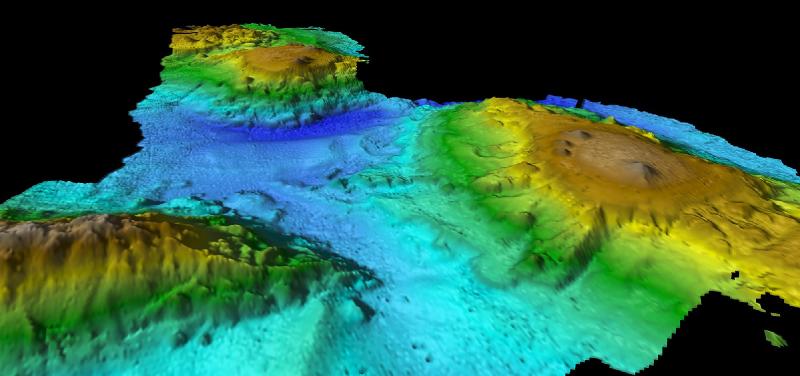Huge underwater volcano chain discovered off the coast of Tasmania



While mapping the seafloor some 250 miles off the coast of the Australian island of Tasmania, scientists recently discovered what’s being called a “volcanic lost world” deep underwater.
The chain of volcanic seamounts — huge undersea mountains that loom as tall as 9,800 feet, or more than six times taller than the Empire State Building — offer a glimpse into a previously unknown ocean ecosystem.
The seamounts vary in size and shape , with some having sharp peaks and others having plateaus, Tara Martin, a researcher with the Commonwealth Scientific and Industrial Research Organisation in Hobart, Tasmania, said in a statement. But even the tallest seamounts were still at least 6,500 feet below the ocean’s surface.
The scientists also encountered an unusual abundance of marine animals in the area, including humpback and long-finned pilot whales as well as albatrosses, petrels and other seabirds.
The unexpected discovery, made by scientists aboard the organization's research ship Investigator during a 25-day mapping expedition, highlights just how little we really know about the bottom of the ocean .
“We’ve only mapped a tiny fraction of the ocean floor,” said Andrew Fisher, a marine geologist at the University of California, Santa Cruz, who was not involved in the new discovery. “We have more detailed maps of Mars , Venus and the moon than we do of the seafloor. Other planetary bodies can be mapped in high resolution with satellites, but on Earth, the water layer gets in the way. The only way is to go out with ships.”
More than 80 percent of the ocean remains unmapped and unexplored , according to the National Oceanic and Atmospheric Administration. That’s because it’s difficult and time consuming to create detailed seafloor maps. Sonar-equipped research vessels like the Investigator must make a series of passes over an area in a process Fisher likened to mowing a lawn.
Read more at the seeded content
Tags
Who is online
41 visitors

This is a major discovery. This is a massive volcanic system. With so little of the sea floor mapped, this might be a call to map our ocean's floor.
It is a major discovery. We know so little about the ocean that I would hope in the future we spend more time and money discovering the place that 7 billion of us call home.
Crickey..this is down my neck of the woods...All around my area there are extinct volcanoes and plugs etc...So hope these don't decide to become active on day...
I don't think you have to worry about that Shona....I had a plug put in them decades ago.
I think thats right in the "ring of fire" isn't it?
Doesn't that extend down past (south of) Australia?
The ''Ring of Fire'' run north of Australia and to the east.
Yeah that was kinda my point.
Maybe this discovery might extend it further south and west than previously known. It kinda hooks around Australia from the north and to the east.
Interesting.
It certainly possible that the ring could extent south of Australia. Presently in encompasses New Zealand which is almost directly east of Australia and over to Chile.
It will be interesting to see further information on this.
I hope this is okay.
A link from the seeded article contains additional information. Among other things there is speculation the volcano chain and included marine ecosystem may provide a roll in migratory paths. Following the link takes you to more undersea images and marine life photos.
Scientists uncover volcanic lost world off the Tasmanian coast
Scientists studying ocean productivity have uncovered a volcanic lost world teeming with marine life off the Tasmanian coast.